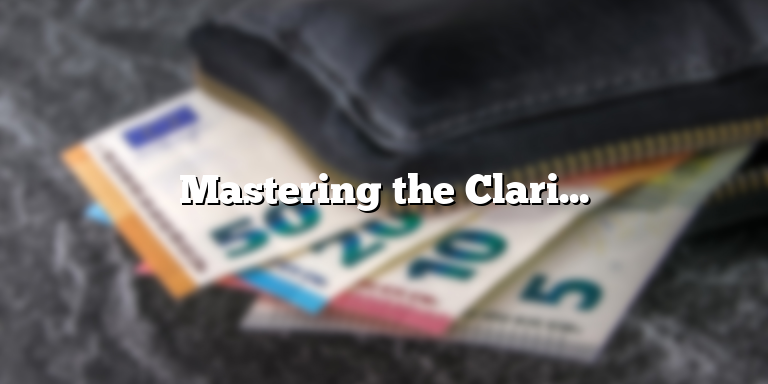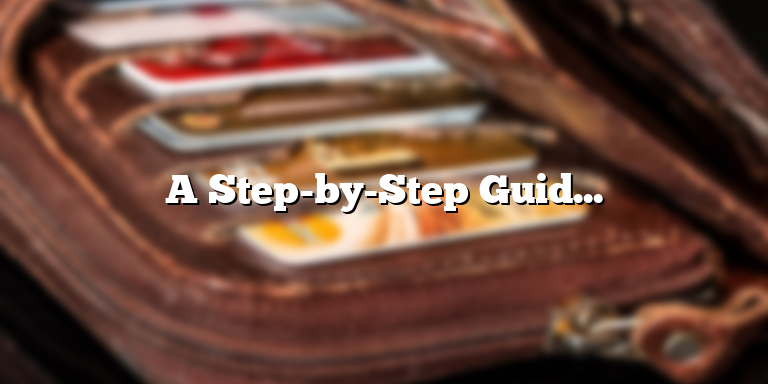
Choosing a Clarinet
Before you start playing the clarinet, you must first choose the right instrument. When selecting a clarinet, you should consider the quality of sound, durability, and affordability. Check the quality of the tone produced by the clarinet and ensure it meets your expectations. Remember that the higher the quality of the clarinet, the more expensive it is likely to be.
If you are a beginner, there’s no need to break the bank on an expensive clarinet. Most experts recommend beginners start with a plastic clarinet, as they are usually less expensive, durable, and maintenance is relatively easy. Wooden clarinets are generally for professional players, and they tend to produce a more resonant sound, but they require more maintenance. When choosing a clarinet, ensure that it comes with a mouthpiece, a case, and a cleaning kit.
Assembling the Instrument
Once you have chosen your clarinet, the next step is to learn how to assemble it. Start with the mouthpiece and reed. First, moisten the reed with saliva for approximately 30 seconds before placing it on the mouthpiece. The ligature is used to hold the reed securely onto the mouthpiece. Tighten the screws of the ligature evenly ensuring that it is firmly and tightly held in place.
The next step is to connect the barrel to the upper joint, followed by the lower joint. Make sure that all joints slide together effortlessly and that there are no gaps left between them. Finally, connect the bell to the lower joint to complete the assembly of the clarinet.
Getting the Right Posture and Hand Position
To play the clarinet effectively, it’s essential to have the correct posture and hand position. Start by sitting straight with your feet flat on the floor and your head held high. Rest the clarinet on your lap, with the barrel and mouthpiece pointing upwards.
Next, the fingers of your left hand should go over the six side keys, while the right-hand fingers should go over the five finger keys. Your thumbs should sit on the thumb rests on the back of the clarinet.
Ensure that your fingers are always curved and resting gently on the keys. When playing the notes, lift your fingers off the clarinet keys gently and quickly.
Breathing and Playing Techniques
Before playing any note, you should take a deep breath and relax. The air is essential when playing the clarinet, and so it’s necessary to take a breath that is deep, relaxed, and controlled.
Place the mouthpiece between your lips and press your lips towards each other. Ensure that the reed is vibrating when you blow through the mouthpiece and that the sound produced is stable. As you blow, apply pressure from your diaphragm to produce the desired sound.
It’s often a good idea to start playing simple notes and gradually progressing to more complex ones. Practice slowly at first and ensure that each note is correctly played before moving to the next one.
Conclusion
Playing the clarinet is a great way to express yourself through music. With practice and consistency, anyone can become a skilled clarinet player. Choosing the right instrument, assembling it accurately, getting the right posture and hand position, and practicing the proper breathing and playing techniques will undoubtedly help you become a better clarinet player. Remember, practice makes perfect, and you can always enjoy playing music, even as a beginner.
Getting Set Up
Are you a beginner at playing the clarinet? Don’t know where to start? We’ve got you covered. Before you can play, you need to set up your equipment. Here are three crucial steps for getting started:
Assemble the Clarinet
The first step to playing the clarinet is assembling the instrument. Don’t worry if you’re not sure what goes where, as it’s a simple process. Start by attaching the bell to the lower joint of the instrument. Next, connect the upper joint and the barrel. Finish off by attaching the mouthpiece and ligature to the top of the barrel. And voila! Your clarinet should now be fully assembled and ready to play!
Check the Reed
The reed is the small, thin piece of wood that is placed onto the mouthpiece and vibrates when air is blown through the instrument. It’s important to check the reed before playing, as a damaged reed can negatively impact the sound quality. Inspect the reed and ensure that it’s not chipped or cracked. If it is, replace the reed with a new one. Carefully moisten the new reed with your tongue, and then place it onto the mouthpiece’s flat surface, securing it with the ligature. If everything looks good, you can proceed to the next step.
Secure the Ligature
The ligature is used to hold the reed on the mouthpiece of the clarinet. It’s important to ensure that the ligature is tight enough to hold the reed in place, but not so tight that it distorts the sound. To do this, place the ligature around the reed and mouthpiece, positioning it so that it’s centred and even. Tighten the screws, but not too much – the reed should be able to vibrate, as this is what creates the sound. Once the ligature is secure, you’re ready to start playing!
By following these steps, you can set up your clarinet correctly and start producing beautiful music. Happy playing!
The Basics
If you’re looking to learn how to play a clarinet, it’s important to start with the basics. The first step is to make sure you’re holding the instrument correctly. Begin by sitting up straight with your back well-supported. Rest your left-hand thumb in the thumb rest at the back of the instrument, while your remaining fingers should go on the keys located in the upper section of the clarinet. On the other hand, your right hand should rest on the keys located in the lower section of the clarinet, and your thumb should be placed on the thumb rest at the bottom of the instrument.
Once you have your fingers in place, you’re ready to insert the mouthpiece. Take the reed and wrap your lips around it. Ensure that your top teeth are resting on the mouthpiece while pushing the reed gently between your lips. Be sure to wet the reed to ensure it does not waver when playing a note. Also, it is important to note that you must not completely close your mouth around the reed because it will prevent the air from passing through the mouthpiece and creating the sound you need. Finally, press down on the key located on the left-hand side of the clarinet’s body close to the barrel while blowing air slowly into the mouthpiece. This should produce a sound.
Posture and Positioning
Now that you have an idea of how to hold the clarinet properly, let’s take a look at the correct posture and positioning. Firstly, make sure that your shoulders are not hunched as you play the instrument to prevent neck and back pain. Most importantly, keep your head held high to secure a stable position for the mouthpiece. Secondly, place your feet flat on the ground with your legs uncrossed, to maintain balance while in the playing position. Lastly, ensure that your fingers remain relaxed, and only apply the necessary pressure, when pressing down on the instrument keys to avoid clumsiness and fatigue on your hands.
Understanding Notes and Scales
To master the clarinet, it is essential to have a good understanding of music theory. Notes and scales are fundamental elements of any musical instrument. A scale is a sequence of musical notes arranged with a specific pattern of intervals- which is the distance between different pitches- between them. For instance most scales in Western music have eight notes where ‘Do’ or ‘C’ is the first and last note. A beginner should start by familiarizing themselves with the C major scale. It is the most basic and gives an overview of essential notes on the clarinet. The C major scale is played on a clarinet by fingering the notes consecutively in order from low to high, pressing the keys in the lower joint.
By developing an understanding of scales and notes, you begin to build the foundation for your playing ability on the clarinet. Spend time mastering the scales and notes, and you’ll be surprised how fast you’ll improve. With constant practice, you’ll be able to play more complex melodies on your clarinet.
The Next Steps
So you’ve mastered the basics of playing the clarinet, and now you’re ready to take your skills to the next level. Here are some suggestions for what to do next:
Try Out Simple Tunes
Once you have the basics of playing the clarinet, it’s time to start building a repertoire. Find some simple tunes that you enjoy and are within your skill level, and start practicing them. Some good examples might include “Hot Cross Buns” or “Mary Had a Little Lamb.”
Playing simple tunes will help you develop your technique and improve your overall sound. Plus, it’s a lot of fun to be able to play a recognizable tune!
Learn to Read Sheet Music
Sheet music is the language of music, and as a clarinet player, you will need to be able to read it fluently in order to play more complex pieces. If you haven’t already, it’s important to start learning how to read sheet music.
You can find plenty of resources online to help you get started with this. There are also many beginner-level books and courses available that can help you improve your skills.
Join Other Musicians
Playing music with others is a great way to build your skills and get more comfortable with your instrument. Find other clarinet players in your area or join a local music group to get started.
Playing with others will help you learn how to listen carefully, follow along, and interact with other musicians. It’s also a lot of fun to collaborate with others and create beautiful music together.
Continue Practicing
Finally, don’t forget to continue practicing regularly. While it’s important to take breaks and give your body time to rest, the only way to continue improving is to keep at it.
Try to set aside a regular practice time each day or each week, and stick to it as much as possible. With persistence and dedication, you’ll be able to take your clarinet playing to the next level!
The Final Touches
Now that you have learned the basics of clarinet playing, it’s time to focus on some other aspects that will help you master the art even better. Here are some final touches you can use to enhance your skills:
1. Tone Production
The sound produced by a clarinet is a combination of the player’s embouchure, fingering, and air support. To improve your tone, try playing long tones and focusing on breathing properly. Make sure that your embouchure, or the way you shape your mouth around the mouthpiece, is consistent and firm. Practice playing at different dynamic levels with the same tone quality.
2. Articulation
Articulation refers to the way you initiate notes, whether it’s using the tongue, fingers, or air pressure. Use different articulation techniques like legato, staccato, and accents to add variety to your playing. Make sure that your tongue is touching the reed lightly, and not slamming it against the mouthpiece.
3. Expression
Playing music is not just about getting the notes right, but also about expressing emotions and telling a story. To add expression to your playing, focus on dynamics, phrasing, and tempo. Experiment with different interpretations of the music and try to convey different moods through your playing. Listen to recordings of different artists and observe how they add expression to their playing.
4. Maintenance
A well-maintained instrument will produce better sound quality and last longer. Clean your clarinet regularly using a swab and a cloth, oil the keys, and check for leaks or damages. Store it in a safe and dry place, and make sure that the reeds are dry before storing them. Invest in a good-quality case to protect your clarinet from dust, moisture, and other environmental factors.
5. Performance
Playing in front of an audience can be nerve-wracking, but it’s also a great way to showcase your skills and get feedback. Join a local band or orchestra, attend music camps or workshops, or participate in competitions. Practice performing in front of friends or family members, and record yourself to assess your progress. Remember that mistakes are normal, and focus on enjoying the experience and sharing your music with others.
By following these final touches, you can take your clarinet playing to the next level. Remember that practice and patience are key, and don’t be afraid to experiment and have fun while playing. With dedication, you’ll be able to play like a pro in no time!






